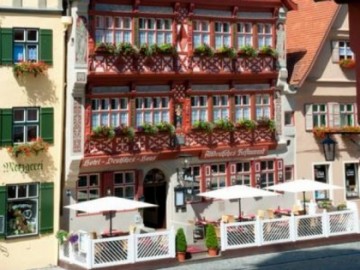Dinkelsbühl: Fabulous City on the Romantic Road
Dinkelsbühl is considered one of the main decorations of the Romantic Road (Romantische Straße) stretching across Bavaria. The breath of the medieval history is felt at every step here. Streets look like a set design. Back in 1962, appreciating the local zest, filmmakers decided to shoot here the US-German film adaptation of the world famous fairy tales of the Grimm Brothers. The film won the Oscar for the Best Costume Design. The broad market streets, the gloomy Gothic cathedral, unusually colorful houses with peaked roofs, wrought iron signs, the elegant Wine Square (Weinmarkt) always delight the traveler eyes ...
Cafes, bars and restaurants in Dinkelsbühl
See all
Restaurants

Goldenes Lamm Dinkelsbühl
Restaurant • Hotel
+49 9851 2267
Payment methods:

Zum Wilden Mann
Restaurant • Brewery
+49 9851 552525
Payment methods:

Deutsches Haus
Restaurant • Hotel
+49 9851 6058
Payment methods:

Frankischer Hof
Restaurant • Hotel
+49 9851 57900
Payment methods:
Nearby









 Museums and Exhibitions
Museums and Exhibitions
 Architectural Monuments
Architectural Monuments
 Other places
Other places


